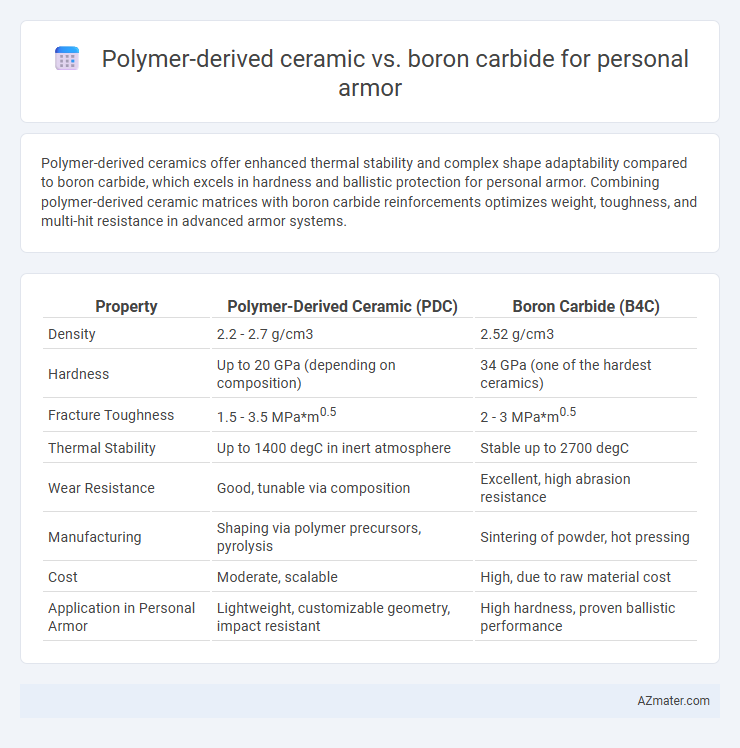Polymer-derived ceramics offer enhanced thermal stability and complex shape adaptability compared to boron carbide, which excels in hardness and ballistic protection for personal armor. Combining polymer-derived ceramic matrices with boron carbide reinforcements optimizes weight, toughness, and multi-hit resistance in advanced armor systems.
Table of Comparison
| Property | Polymer-Derived Ceramic (PDC) | Boron Carbide (B4C) |
|---|---|---|
| Density | 2.2 - 2.7 g/cm3 | 2.52 g/cm3 |
| Hardness | Up to 20 GPa (depending on composition) | 34 GPa (one of the hardest ceramics) |
| Fracture Toughness | 1.5 - 3.5 MPa*m0.5 | 2 - 3 MPa*m0.5 |
| Thermal Stability | Up to 1400 degC in inert atmosphere | Stable up to 2700 degC |
| Wear Resistance | Good, tunable via composition | Excellent, high abrasion resistance |
| Manufacturing | Shaping via polymer precursors, pyrolysis | Sintering of powder, hot pressing |
| Cost | Moderate, scalable | High, due to raw material cost |
| Application in Personal Armor | Lightweight, customizable geometry, impact resistant | High hardness, proven ballistic performance |
Introduction to Advanced Personal Armor Materials
Polymer-derived ceramics (PDCs) offer enhanced thermal stability and toughness compared to traditional ceramics, making them promising candidates for advanced personal armor materials. Boron carbide (B4C), known for its exceptional hardness and lightweight properties, remains a benchmark in ballistic protection. The integration of PDCs aims to overcome the brittleness of boron carbide, potentially providing superior impact resistance and multi-hit capabilities in next-generation personal armor systems.
Overview of Polymer-Derived Ceramics (PDCs)
Polymer-derived ceramics (PDCs) are advanced materials synthesized through the pyrolysis of preceramic polymers, offering unique microstructural control and enhanced thermal stability for personal armor applications. PDCs exhibit excellent hardness, high fracture toughness, and superior resistance to wear and corrosion compared to conventional ceramics like boron carbide. These attributes enable the development of lightweight, durable armor systems with improved ballistic performance and longer service life under extreme conditions.
Properties and Performance of Boron Carbide
Boron carbide (B4C) is renowned for its exceptional hardness, ranking third after diamond and cubic boron nitride, which results in superior ballistic protection and resistance to impact in personal armor applications. Its high compressive strength (up to 2,650 MPa) and low density (2.52 g/cm3) make it lightweight yet extremely durable, outperforming polymer-derived ceramics that typically have lower hardness and fracture toughness. The exceptional wear resistance and chemical stability of boron carbide enhance the longevity and reliability of armor systems exposed to harsh environments.
Weight Considerations in Personal Armor Design
Polymer-derived ceramics (PDCs) offer significant weight reduction compared to boron carbide due to their lower density and customizable microstructure, enhancing mobility without compromising ballistic protection. Boron carbide, while exceptionally hard and chemically stable, is denser and can increase the overall weight burden on the wearer. Optimizing weight considerations in personal armor design favors PDCs for lightweight, high-performance applications where agility and endurance are critical.
Ballistic Protection Capabilities
Polymer-derived ceramics (PDCs) offer superior toughness and thermal stability compared to boron carbide, enhancing multi-hit ballistic protection in personal armor applications. Boron carbide excels in hardness and lower density, providing high initial impact resistance against armor-piercing projectiles but tends to exhibit brittle failure under extreme stress. Integrating PDCs with boron carbide composites can optimize ballistic performance by combining hardness with improved fracture toughness and energy absorption.
Durability and Impact Resistance
Polymer-derived ceramics exhibit superior thermal stability and chemical resistance, enhancing their durability in extreme conditions compared to boron carbide. Boron carbide, known for its exceptional hardness and lightweight properties, provides outstanding impact resistance and ballistic performance in personal armor. Combining polymer-derived ceramics with boron carbide creates advanced composite armor materials that optimize both durability and impact resistance for enhanced soldier protection.
Cost-Effectiveness and Manufacturing Processes
Polymer-derived ceramics (PDCs) offer cost-effectiveness in personal armor due to lower raw material expenses and scalable manufacturing via pyrolysis of pre-ceramic polymers, enabling complex shapes and lightweight structures. Boron carbide, while highly effective for ballistic resistance, involves costly raw materials and energy-intensive sintering processes, increasing overall production costs. The manufacturing flexibility of PDCs allows quicker prototyping and customization, providing an economic advantage over the more rigid and expensive boron carbide fabrication methods.
Thermal and Chemical Stability
Polymer-derived ceramics exhibit superior thermal stability, maintaining structural integrity at temperatures exceeding 1200degC, whereas boron carbide tends to degrade near 900degC, limiting its high-temperature performance. Chemically, polymer-derived ceramics resist oxidation and corrosive environments effectively due to their amorphous silicon oxycarbide matrix, offering enhanced durability compared to the crystalline boron carbide, which may undergo chemical erosion. These attributes make polymer-derived ceramics particularly advantageous for personal armor applications requiring sustained protection in extreme thermal and chemically aggressive conditions.
Application Scenarios in Military and Law Enforcement
Polymer-derived ceramics (PDCs) offer superior thermal stability and crack resistance, making them ideal for military armor in extreme combat environments where high-temperature tolerance is essential. Boron carbide excels in ballistic protection due to its exceptional hardness and lightweight properties, widely used in law enforcement body armor for enhanced mobility and durability during urban engagements. Both materials provide critical advantages tailored to specific threat levels and operational scenarios, with PDCs suited for advanced multi-threat protection and boron carbide optimized for fast-response personal defense.
Future Prospects and Material Innovations
Polymer-derived ceramics (PDCs) exhibit promising future prospects in personal armor due to their tunable microstructure and high thermal stability, offering enhanced crack resistance compared to traditional boron carbide (B4C). Innovations in PDCs focus on incorporating nanostructured reinforcements and hybrid composites to improve fracture toughness and reduce weight, addressing boron carbide's brittleness limitations. Advances in additive manufacturing techniques enable precise control over PDC architecture, potentially revolutionizing personal armor development through customized, lightweight, and highly durable protection solutions.

Infographic: Polymer-derived ceramic vs Boron carbide for Personal armor
 azmater.com
azmater.com